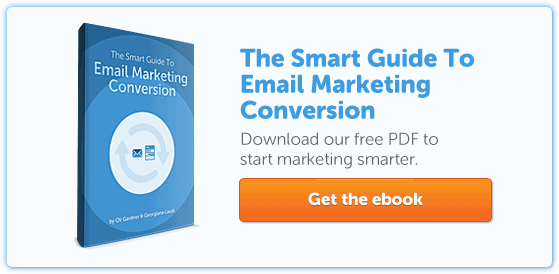
If you want to keep growing your email list, you need a powerful email opt-in offer that stands out and captures the attention of your audience. One that shows why prospects absolutely need to sign up for your email newsletter.
Using an open loop email opt-in technique is one of the best ways to craft a unique opt-in offer; like the teaser at the end of a weekly drama series, your opt-in should give away just enough to make a viewer want to tune in for the next episode.
But how do you know which copy will pique your audience’s curiosity and make it so they just have to sign up for your emails?
Here are five things you need to know if you want to write compelling opt-in copy that is sure to convert.
1. What are your goals?
Before telling potential readers what to expect, it’s a good idea to ask yourself what you expect out of them.
What are you most hoping to encourage in email list followers?
Additional product purchases from returning customers? An eventual, one-time conversion? More traffic? Or just engagement on social media and blog posts?
You must know what you’re gunning for before you decide on the specifics of your opt-in. Why? Because understanding your goals will shape the way you present and design your opt-in.
For example, there’s a trade-off between short-term conversions and long-term engagement when considering whether or not to ask for a name in the email opt-in form.
Studies show that asking for names lowers the conversion rate but raises the “quality” of those who do convert, in terms of email open rate and engagement later on.
Would you rather bulk up your list now and risk a lower open rate later, or lower the size of your list and increase the percentage of conversions? The answer depends on the goals behind the campaign.
2. What are your peers and competitors doing?
Seeing what your peers offer helps you determine your unique place in the market. What can you provide via email that others aren’t already giving away?
Email service providers won’t spill the stats on which of your competitors get the best opt-in rate, but you can get a feel for who is having success with their content.
Researching leading blogs in your niche gives you some insight into what your audience finds valuable.
Start by finding leading blogs in your niche
Tools like BuzzSumo help determine the most popular articles on any topic. The site ranks blog posts by who’s getting the most shares on any given topic.
For example, let’s say I have a small fashion blog. I could create a BuzzSumo search around “best outfits for fall” or any other topic I think my audience is likely to be searching for.
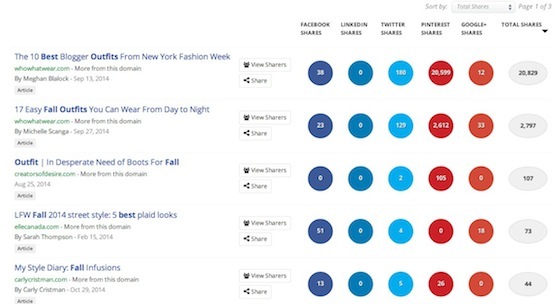
Then, engage in shameless stalking research
The top two posts for this search both come from WhoWhatWear.com. This site clearly holds some influence in this vertical.
After a minute browsing WhoWhatWear, I’m greeted by an opt-in pop-up – and it’s a pretty enticing pitch:
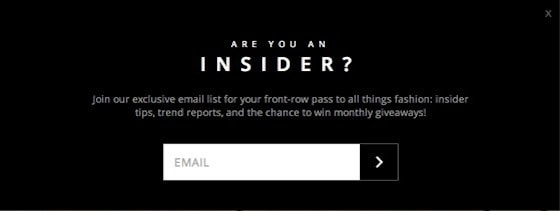
Look at the words they’re using: “exclusive,” “insider,” “front-row pass.” The simple black and white design looks like an invitation to a classy event. This invite was clearly created with its young fashionista audience in mind.
How do influencers advertize their email list?
If I was on my way to creating the next great fashion blog and newsletter, I’d spend the next few hours combing over how these other influencers advertize their email lists.
- What wording and terms do they use?
- What unique content and incentives do they promise? (And how are my unique offerings different?)
- Do they advertize their email signups on Facebook, Twitter or Pinterest? What copy do they use there?
Use the information you gather from the competitive landscape to craft an email opt-in that pulls in interest (and one-ups your competitors).
Be sure you’re answering the question your prospects are already asking: Why should they subscribe to your emails instead of “the other guy?”
3. What does your audience already love about you?
One of the best places to look for copywriting advice is your own successes. Take a look at your Facebook and Twitter metrics. Which posts have garnered the most clicks, likes, favorites or shares?
This information can help you decide what info to continue sharing on Facebook or Twitter, but it also gives you insight into your company’s best offerings.
Knowing which posts draw the most (and least) attention from your existing audience gives you more insight into the type of newsletter they’d be willing to opt in to.
For a simple start, try taking your most shared post and reworking its copy into something that can be offered as an email opt-in for your email pop-up.
I’ve been traveling lately, so the TripAdvisor Facebook page comes to mind as an example. Scrolling through the past month or so of posts, TripAdvisor is getting the most social shares from posts on “why people travel.”

TripAdvisor could alter their current on-site email opt-in copy to mention more of these clearly popular posts. For example:
Sign up for our travel-loving email community and tell us why you travel for a chance to be featured on our Facebook page.
Go deep into the data
For a more in-depth look, I’d recommend exporting Facebook and Twitter data to a spreadsheet and sorting by various engagement metrics:
- The posts with the most comments tell you what kind of conversations the audience is naturally interested in.
- The posts with the most “likes” or “favorites” tell you what announcements or stories the audience wants to hear more about.
Try working these stories into an open-loop email newsletter offer – what proven popular conversations or offers can be teased out in the opt-in copy, then satisfactorily answered in the email newsletter?
Bonus tip:
Instead of simply retweeting others’ posts on Twitter, post the content from your own handle and give the creator attribution with “via @username.” This way, the post shows up in your Twitter analytics and can help you determine if the content of this post was more or less interesting to your audience.
4. What do the analytics say?
This next tactic comes from a similar place as the social media research above: instead of telling your site visitors why they should want to opt in, why not use their behavior to “ask” what content they’re interested in?
Google Analytics gives you metrics to optimize for visitors new and old.
Which keywords are pulling in organic traffic?
The organic keywords under the “Acquisition” tab of Google Analytics tells you what terms are leading new visitors to the site. This is a great way to develop opt-in copy that reflects the reason visitors arrive on the page to begin with.
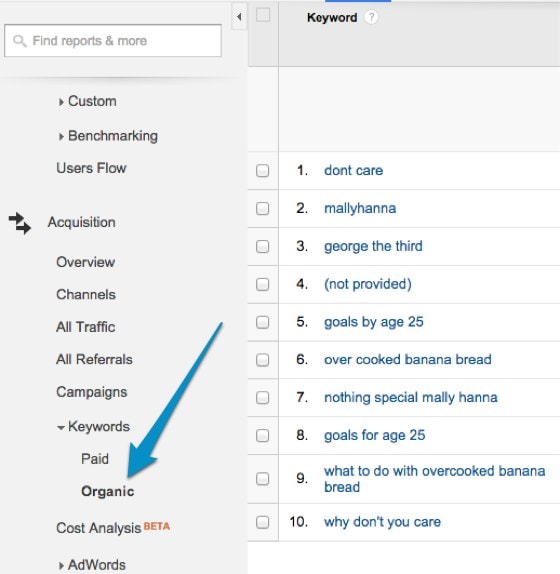
There may be some popular keywords that have nothing to do with your vision for the brand. I’m not suggesting writing email opt-in copy on topics you never plan to deliver content on, but most keywords will have parallels to your target audience and content related to your brand.
These are the terms to pay attention to and possibly build on in email opt-in copy and elsewhere on the site.
Where are the repeat visitors going?
Another Google Analytics stat to help inform email opt-in copy can be found by looking at return visitors’ pageviews.
This stat be found under the “Behavior” tab in the left-hand sidebar. Click on “Site Content” > “All Pages” and then add a secondary dimension for “User Type” and filter by “Returning Visitor.”
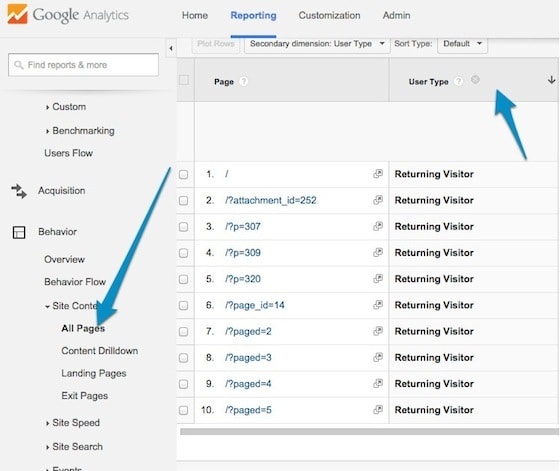
Returning visitors are a step above the casual scroller. They’ve come back to the site; they’re more engaged with the brand than a new visitor may be. Looking at the posts and pages they’re viewing most frequently, what do these views say about the content brand followers come back for?
Going back to the goals you set in the beginning, do you want to pull first-time visitors back again and again, or do you want a smaller, more passionate email subscriber list? Asking these questions will give you the answers you need to create opt-ins that meet your specific goals.
5. Which benefits have resonated in your email marketing?
For a brand with existing email marketing campaigns, you can go a step further into discovering your audience’s likes and dislikes by looking at the metrics from sent newsletters.
As with previous metrics, understanding the most popular content tells you which topics to tease in your opt-in copy.
Email campaign metrics to pay attention to:
- Which subjects lines have drawn the highest open rate?
- Which subject lines have drawn the best click-through rate?
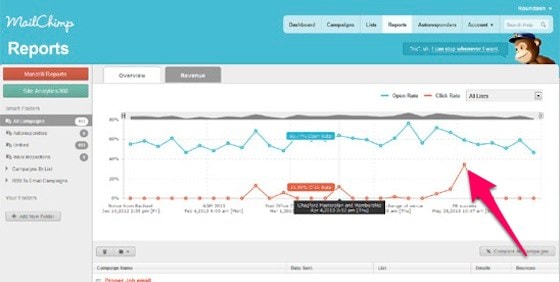
In the report above from MailChimp, the top bar shows the open rate for each email, and the bottom bar shows the email’s click through rate.
For newsletters with higher-than-usual open rates, you can look at the subject line and preview text to see what news and copy most enticed subscribers.
And for newsletters with high click-through rates (like the anomaly on the right-hand side of the screenshot above – the one with the hot pink arrow!), you can unpack what in-email copy most excited subscribers.
These metrics give you access to already-successful offerings to test in your opt-in copy.
Test to validate your hypothesis
Once you’ve collected all your research and written really killer opt-in copy, your job isn’t done (sorry).
While this research will equip you with the information you need to create great hypotheses, the only way to validate what really resonates is to test.
The beauty of this approach is that it allows you to constantly improve and iterate your opt-in copy, all while keeping up with site pivots and changing industry trends.
What do you research before you sit down to write email opt-in copy? I’d love to hear in the comments!
![]()
